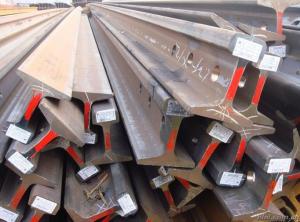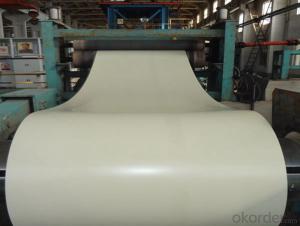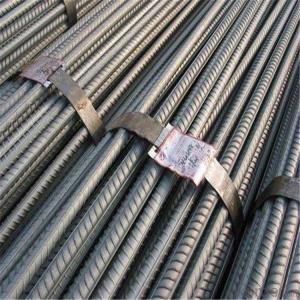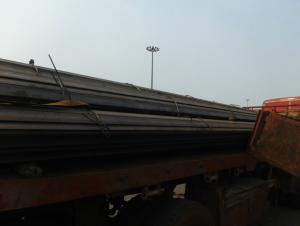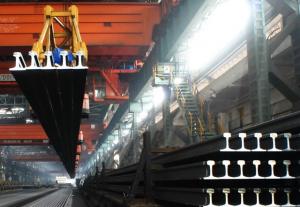Steel Heavy Rail with High Quality for Structure Project and Building
- Loading Port:
- China main port
- Payment Terms:
- TT or LC
- Min Order Qty:
- 25 m.t.
- Supply Capability:
- 100000 m.t./month
OKorder Service Pledge
OKorder Financial Service
You Might Also Like
Product Description of Steel Heavy Rail with High Quality for Structure Project and Building:
Sizes: 38kg, 43kg, 45kg, 50kg, 60kg.
Production Standard: GB2585-81, DIN, AREMA, JIS, BS, UIC, etc.
Material: 50MN, U71MN, 900A, 110A, etc.
Length: 6m-25m according to the requriements of the clients
Usages of Steel Heavy Rail with High Quality for Structure Project and Building:
Light rail is mainly used in forest region, mines, factories and construction sites laid of the place such as temporary transport line and light motorcycles with line. Be widely used for railway, subway, transportation track, express, curve way, tunnel way and so on.
Packaging & Delivery of Steel Heavy Rail with High Quality for Structure Project and Building:
1. Packing: it is nude packed in bundles by steel wire rod
2. Bundle weight: not more than 3.5MT for bulk vessel; less than 3 MT for container load
3. Marks:
Color marking: There will be color marking on both end of the bundle for the cargo delivered by bulk vessel. That makes it easily to distinguish at the destination port.
Tag mark: there will be tag mark tied up on the bundles. The information usually including supplier logo and name, product name, made in China, shipping marks and other information request by the customer.
If loading by container the marking is not needed, but we will prepare it as customer request.
4. Transportation: the goods are delivered by truck from mill to loading port, the maximum quantity can be loaded is around 40MTs by each truck. If the order quantity cannot reach the full truck loaded, the transportation cost per ton will be little higher than full load.
5. Delivered by container or bulk vessel
6. Delivery Time: All the Hot Rolled Steel Rail will be transpoted at the port of Tianjin, China within 30 days after receiving the advance payment by T/T or the orginal L/C at sight.
Inspection of Steel Heavy Rail with High Quality for Structure Project and Building:
We will send the MTC of the factory to the clients dirrectly which contain the anlisis of the heat, chemiqul composition, phisical characteristicas, etc.
And our inspectors will arrive at the factory to meke the inspection of the size, length, weight and quantity before the transportation from the factory.
FAQ:
Q1: How soon can we receive the product after purchase?
A1: Within three days of placing an order, we will begin production. The specific shipping date is dependent upon international and government factors, but is typically 7 to 10 workdays.
Q2: How do we guarantee the quality of our products?
A2: We have established an advanced quality management system which conducts strict quality tests at every step, from raw materials to the final product. At the same time, we provide extensive follow-up service assurances as required.
Q3: Why buy Materials & Equipment from OKorder.com?
A3: All products offered by OKorder.com are carefully selected from China's most reliable manufacturing enterprises. Through its ISO certifications, OKorder.com adheres to the highest standards and a commitment to supply chain safety and customer satisfaction.
Images:
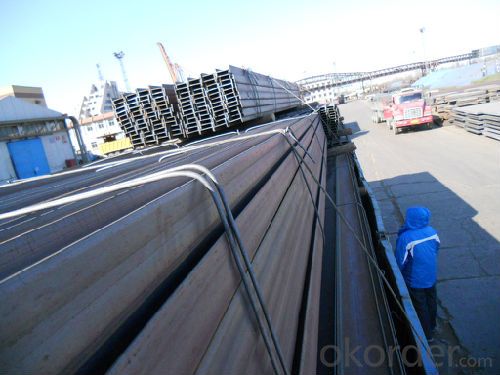
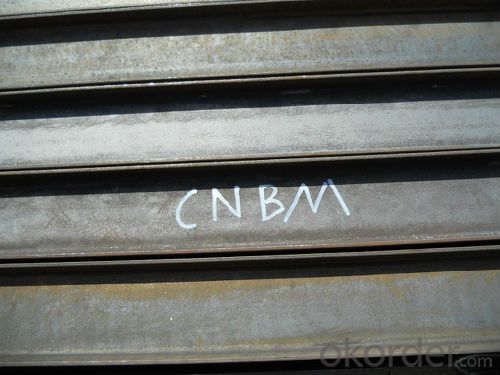
- Q:Can steel rails be used in areas with high salinity?
- Steel rails can be used in areas with high salinity, but their durability and longevity may be affected. Salinity, especially in coastal regions, can lead to corrosion of steel due to the presence of saltwater and salt particles in the air. This corrosion can weaken the steel rails over time, potentially leading to structural issues and safety concerns. To mitigate the effects of high salinity, various measures can be taken. One common method is to use stainless steel or corrosion-resistant alloys for the rail material. These materials have a higher resistance to corrosion, making them more suitable for areas with high salinity. Another approach is to implement a regular maintenance and inspection program. This involves cleaning the rails to remove any salt deposits and applying protective coatings or paints that can provide a barrier against corrosion. Additionally, proper drainage systems and regular monitoring of the rail conditions can help identify and address any potential corrosion issues before they become significant problems. It is important to consider that despite these measures, the overall lifespan of steel rails in areas with high salinity may still be reduced compared to those in low-salinity environments. Therefore, it is crucial for railway authorities and operators to carefully assess the salinity levels and associated risks before deciding on the suitability of steel rails in such areas.
- Q:Are steel rails used in bridges?
- Yes, steel rails are commonly used in bridges. Steel rails, also known as railroad tracks, are used to support and guide trains. They are designed to withstand heavy loads, provide stability, and ensure smooth movement of trains. Bridges that are designed to carry trains or other heavy vehicles often incorporate steel rails as part of their construction. These rails are typically laid on a track bed or bridge deck and are anchored securely to ensure the safety and functionality of the bridge.
- Q:How do steel rails contribute to the overall stability of train movements?
- Steel rails contribute to the overall stability of train movements by providing a smooth and sturdy track surface. The rails act as a guide for the wheels, preventing the train from derailing or deviating from its intended path. The steel material is highly durable and can withstand heavy loads, ensuring that the track remains in good condition and reducing the risk of accidents. Additionally, the design of the rails allows for efficient weight distribution, minimizing vibrations and ensuring a comfortable and stable ride for passengers.
- Q:Can steel rails be used in railway systems with coastal erosion?
- Railway systems facing coastal erosion can indeed utilize steel rails. Steel is a resilient and weather-resistant material that can endure the harsh conditions associated with coastal erosion. Nonetheless, it is crucial to adopt specific precautions and adjustments to guarantee the longevity and safety of the railway system. Coastal erosion has the potential to destabilize the ground, necessitating comprehensive geotechnical investigations and engineering surveys. These assessments will determine the stability of the ground and enable the design of appropriate foundations for the railway tracks. Additionally, implementing protective measures like constructing seawalls or installing rock revetments can help mitigate the impact of erosion on the railway system. Regular inspections and maintenance are also imperative to monitor any changes in the coastal environment and promptly address any potential problems. Ultimately, while steel rails can be used in railway systems affected by coastal erosion, meticulous planning, design, and maintenance are indispensable in ensuring their effectiveness and safety in such environments.
- Q:What are the advantages of using steel rails in port terminals?
- There are several advantages of using steel rails in port terminals. Firstly, steel rails provide a durable and strong foundation for heavy loads, ensuring the safe transportation of goods. Secondly, steel rails are resistant to wear and tear, reducing maintenance costs and increasing operational efficiency. Thirdly, steel rails offer better stability and traction, enabling smooth movement of trains and minimizing the risk of accidents. Lastly, steel rails are highly versatile and can be easily modified or expanded to accommodate future growth and changes in transportation needs. Overall, the use of steel rails in port terminals enhances efficiency, safety, and flexibility in cargo handling and transportation.
- Q:What are the noise reduction benefits of using steel rails?
- The noise reduction benefits of using steel rails include the ability to dampen vibrations and absorb sound, resulting in quieter train operations. Steel rails also offer a smoother surface for trains to travel on, minimizing friction and reducing noise levels.
- Q:What is the process of reconditioning old steel rails?
- To bring old steel rails back to their original condition and ensure their safe use, a series of steps are involved in the reconditioning process. To begin with, a thorough inspection is conducted to assess the overall condition of the old steel rails and determine the extent of any damage or wear. This inspection involves checking for cracks, corrosion, and any other defects that could compromise the rail's integrity. Once the inspection is finished, the next step involves removing any contaminants or foreign materials from the rail's surface. This cleaning process typically employs specialized equipment such as high-pressure water jets or abrasive blasting to eliminate dirt, rust, and other debris. After cleaning, the rails undergo straightening to correct any bends or warps that may have occurred over time. This ensures that the rail is perfectly straight and properly aligned. Straightening is typically achieved using hydraulic presses or other mechanical methods that exert controlled force to reshape the rail. Following straightening, the rails are subjected to heat treatment to enhance their strength and durability. This process involves exposing the rails to high temperatures, often through induction heating or flame heating, followed by controlled cooling. The heat treatment helps to relieve internal stresses, increase hardness, and improve resistance to wear and fatigue. Once the heat treatment is completed, a final inspection is carried out to verify that the rails meet all required specifications and standards. This includes checking for proper dimensions, surface quality, and other relevant criteria. If the reconditioned rails pass all necessary inspections, they are deemed ready for reinstallation and can be put back into service. However, if any issues or defects are identified during the inspection process that cannot be adequately addressed, additional repairs or even scrapping may be necessary. In summary, reconditioning old steel rails is a meticulous process involving meticulous inspection, thorough cleaning, precise straightening, effective heat treatment, and a final inspection to ensure their safe and reliable use in railway infrastructure.
- Q:What are the environmental benefits of steel rails?
- Steel rails have several environmental benefits. Firstly, steel is a highly recyclable material, which means that old or damaged rails can be melted down and used to produce new ones, reducing the need for new steel production and minimizing waste. Secondly, steel is a durable and long-lasting material, requiring less frequent replacement compared to other rail materials, reducing the overall environmental impact of rail infrastructure. Additionally, steel rails have a high load-bearing capacity, allowing for heavier and more efficient transportation of goods, which can help reduce carbon emissions by promoting the use of trains over trucks or other modes of transportation. Overall, steel rails contribute to a more sustainable and environmentally friendly transportation system.
- Q:How are steel rails recycled?
- Steel rails are typically recycled through a process called rail reclamation, where the old tracks are dismantled, sorted, and sent to a recycling facility. At the facility, the steel rails are crushed into small pieces, then melted down in a furnace. The molten steel is then molded into new steel products, such as construction materials or new railway tracks. This recycling process helps conserve resources, reduces waste, and promotes sustainability in the steel industry.
- Q:What are the safety measures associated with steel rails?
- Safety measures associated with steel rails include regular inspection and maintenance of the rails, ensuring proper alignment and levelness, installing durable barriers to prevent unauthorized access, implementing signal systems to control train movements, and providing appropriate warning signs and signals for pedestrians and vehicles. Additionally, safety measures also involve training railway staff on emergency response procedures, conducting regular safety drills, and implementing strict adherence to speed limits and operating rules.
1. Manufacturer Overview |
|
|---|---|
| Location | |
| Year Established | |
| Annual Output Value | |
| Main Markets | |
| Company Certifications | |
2. Manufacturer Certificates |
|
|---|---|
| a) Certification Name | |
| Range | |
| Reference | |
| Validity Period | |
3. Manufacturer Capability |
|
|---|---|
| a)Trade Capacity | |
| Nearest Port | |
| Export Percentage | |
| No.of Employees in Trade Department | |
| Language Spoken: | |
| b)Factory Information | |
| Factory Size: | |
| No. of Production Lines | |
| Contract Manufacturing | |
| Product Price Range | |
Send your message to us
Steel Heavy Rail with High Quality for Structure Project and Building
- Loading Port:
- China main port
- Payment Terms:
- TT or LC
- Min Order Qty:
- 25 m.t.
- Supply Capability:
- 100000 m.t./month
OKorder Service Pledge
OKorder Financial Service
Similar products
New products
Hot products
Hot Searches
Related keywords
